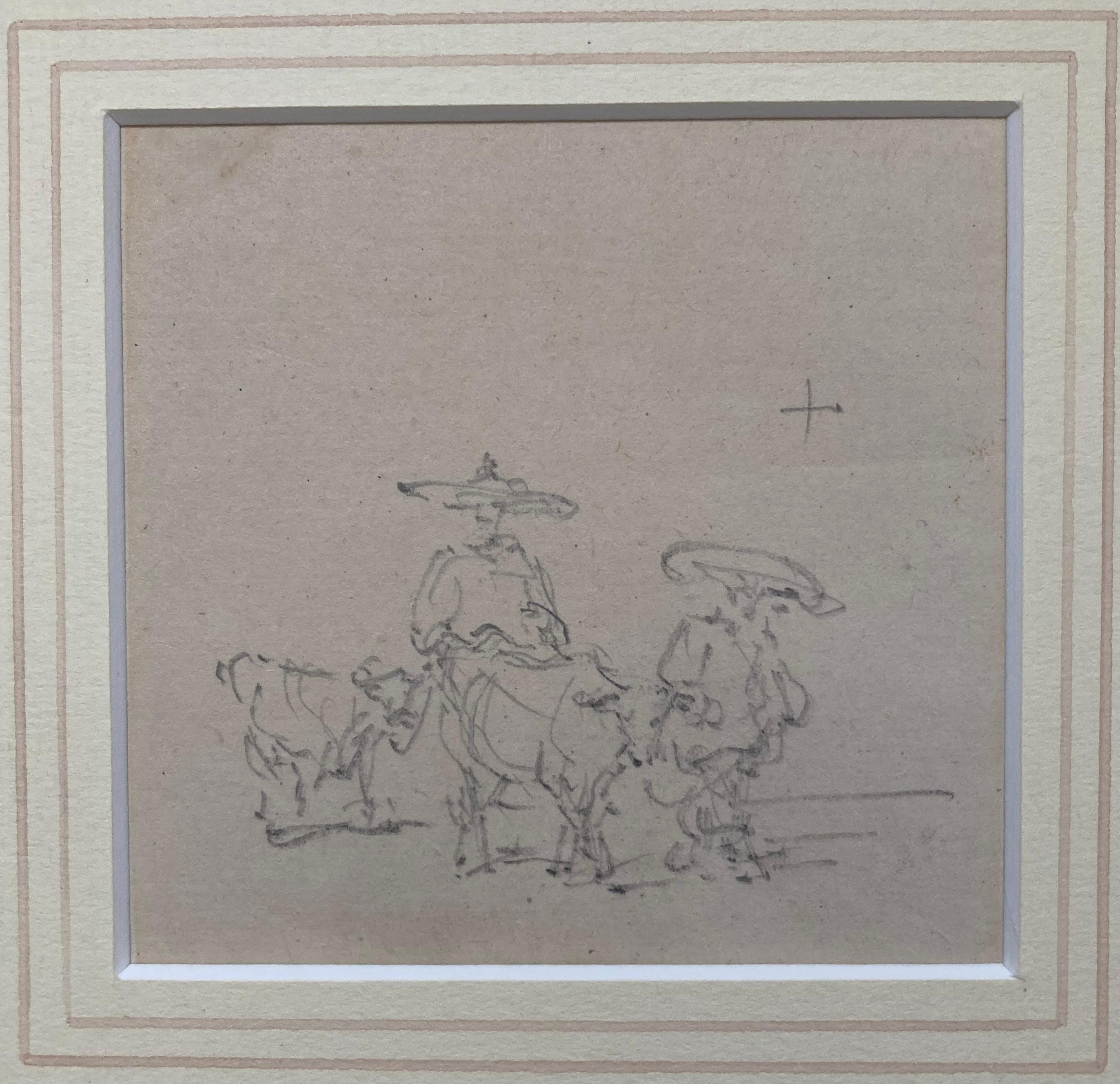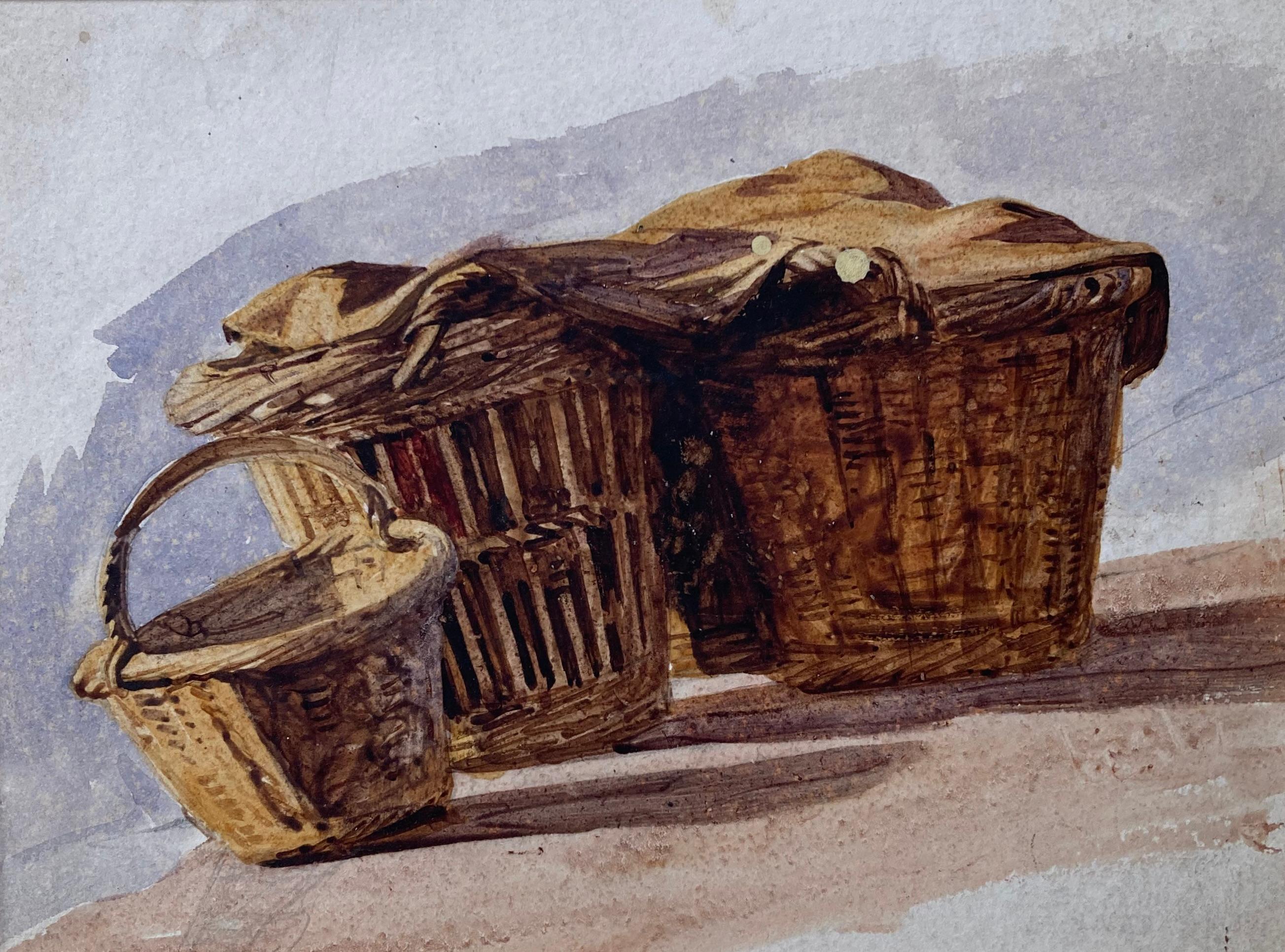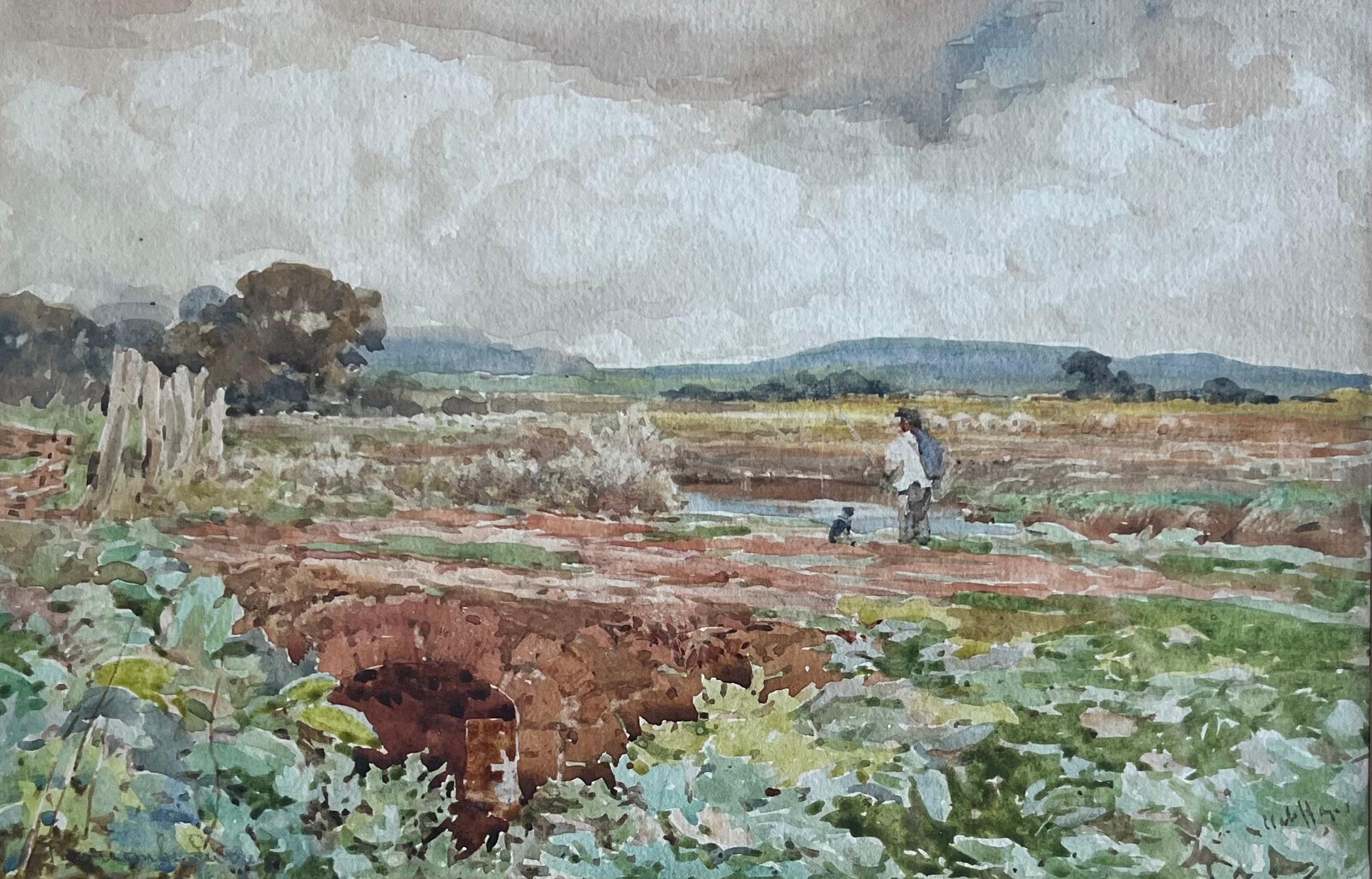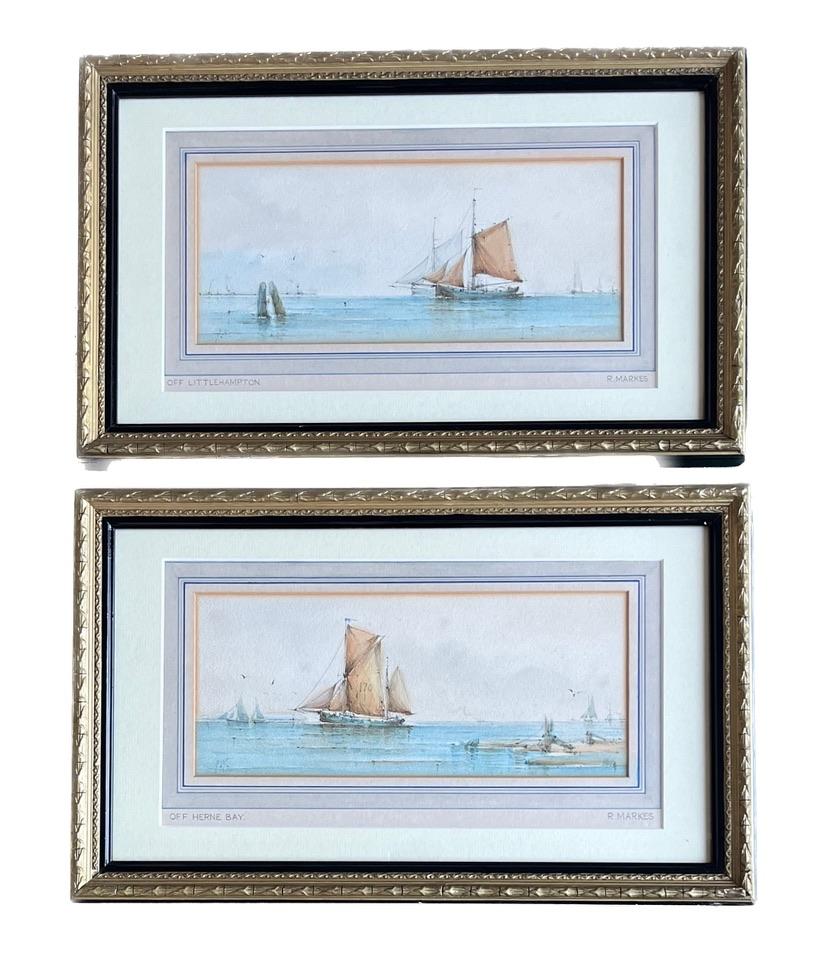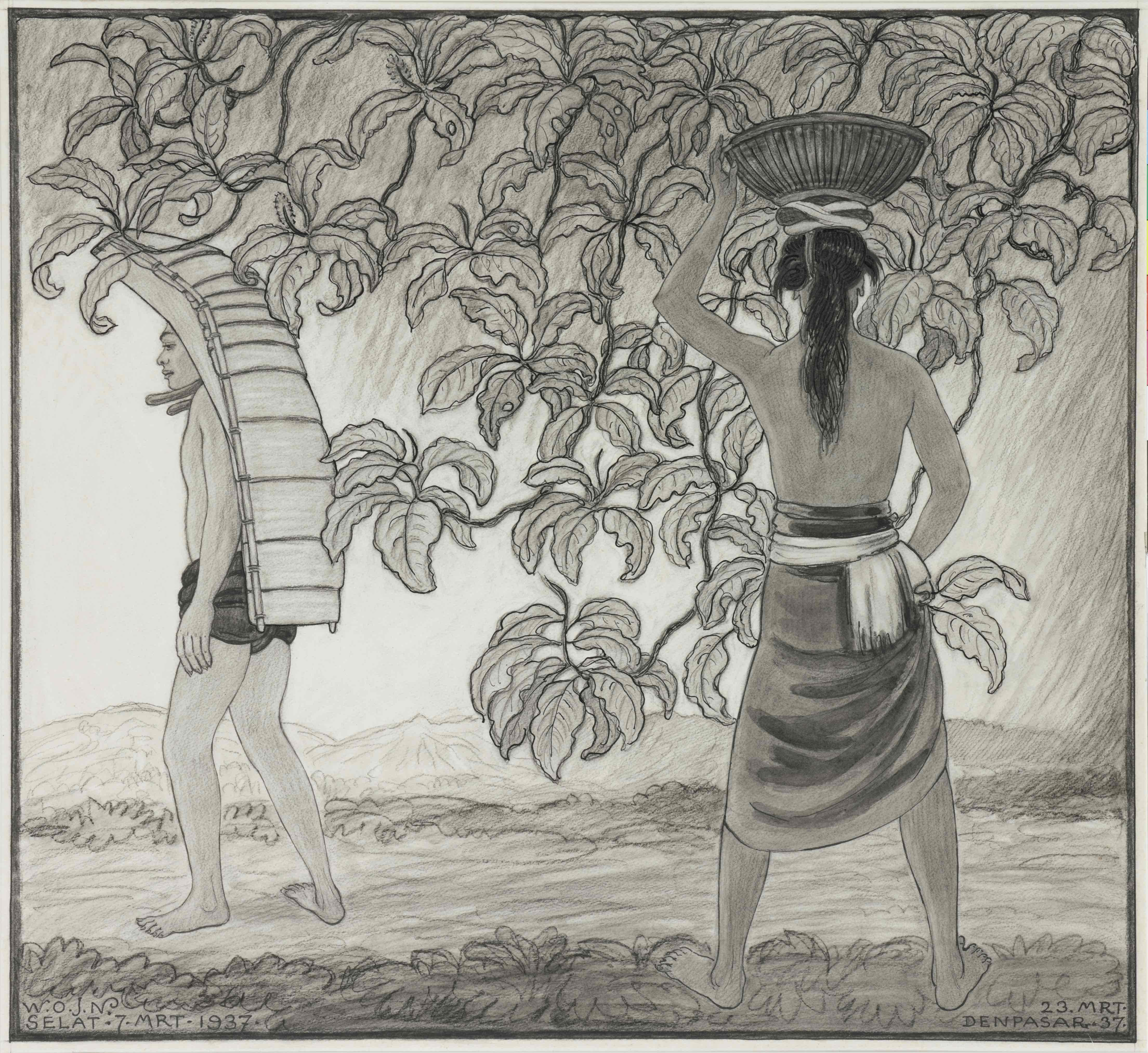Items Similar to Sketch-book Page, Shoreham, Samuel Palmer, Late 19th Century
Want more images or videos?
Request additional images or videos from the seller
1 of 4
Samuel Palmer (b.1805)Sketch-book Page, Shoreham, Samuel Palmer, Late 19th Century
About the Item
Graphite on paper, numerous pencil inscriptions
Image size: 5 1/2 x 21 1/2 inches (14 x 55 cm)
Period style hand made gilt frame
Provenance
The collection of Ernest Pearce (1930-2012) a dedicated art collector and connoisseur of the bookplate.
This drawing, taken from one of Samuel Palmer's sketch books, depicts Mepham Barn in Shoreham. In an articulated design of the landscape, the collection of farm buildings is framed by a wooded thicket and an expansive crop field, creating a cohesive composition. Covering the double page are multiple hand-written annotations given by the artist, noting the colours and hues of the reality of the scene depicted.
Between 1825 and 1832 Palmer executed brilliant studies of the landscape around Shoreham in Kent, a small village just south of London, while he lived there. The seven years formed the artist's most fertile period during which he was able to capture an intense response to a natural harmony born of moonlight and rural scenes. Although after he left almost half a century remained to him in which to paint, he never regained the spiritual vitality of these early years.
Palmer's work at Shoreham was made in isolation, intensely personal, part of a mystical and, often, overtly religious experience, shared only with a few other people. Whilst at Shoreham, Palmer looked long and hard at his surroundings, trying to penetrate the secrets of nature, the structures, and especially the associations with his imaginary landscapes. Palmer's earliest documented visit to Shoreham was in the summer of 1826 but it is often assumed that he visited the village as early at 1824 and had a connection to the location from such an early date.
This sketch of a selection of farm buildings alludes to one of Palmer's favourite motifs in his earlier works - the primitive cottage. The inclusion of this can be found in a number of his drawings in pen and ink from the end of the 1820s. Palmer wrote in his 1824 sketchbook, 'whatever you do, guard against bleakness & grandeur and try for the primitive cottage feeling'. For Palmer, the 'pastoral essence' that he strove to capture was dependant on the primitive cottage, the harmonious interaction of man with nature and the abundance of nature.
This is a rare opportunity to purchase such a work. In 1909, many of his Shoreham works were destroyed by his surviving son Alfred Herbert Palmer, who burnt "a great quantity of father's handiwork ... Knowing that no one would be able to make head or tail of what I burnt; I wished to save it from a more humiliating fate". The destruction included "sketchbooks, notebooks, and original works, and lasted for days".
The Artist
Samuel Palmer was a British landscape painter, etcher and printmaker. He also was a prolific writer and was a key figure in Romanticism in Britain and produced visionary pastoral paintings.
Palmer was born in London, the son of a bookseller and a nurse. Palmer painted churches from around age twelve, and first exhibited Turner-inspired works at the Royal Academy at the age of fourteen. Through John Linnell, he met William Blake in 1824. Blake's influence can be seen in work he produced over the next ten years (generally reckoned to be his greatest). The works were landscapes around Shoreham, near Sevenoaks in the west of Kent. They were among the few who saw the Shoreham paintings as, resulting from attacks by critics in 1825, he opened his early portfolios only to selected friends.
After returning to London in 1835, and using a small legacy to purchase a house in Marylebone, Palmer produced less mystical and more conventional work. Part of his reason in returning to London was to sell his work and earn money from private teaching. He had better health on his return to London, and was by then married to Hannah, daughter of the painter John Linnell who he had known since she was a child, and married when she was nineteen and he was thirty-two. Palmer turned more to watercolour which was gaining popularity in England.
From the early 1860s he gained some measure of critical success for his later landscapes, which had a touch of the early Shoreham work about them – most notable is the etching of The Lonely Tower (1879). He became a full member of the Water Colour Society in 1854, and its annual show gave him a yearly goal to work towards.Palmer's later years were darkened by the death in 1861, at the age of 19, of his elder son Thomas More Palmer – a devastating blow from which he never fully recovered. He lived in various places later in his life, including a small cottage and an unaffordable villa both in Kensington, where he lived at 6 Douro Place, then a cottage at Reigate. But it was only when a small measure of financial security came his way, that was he able to move to Furze Hill House in Redhill, Surrey, from 1862.
Palmer died in Redhill, Surrey, and is buried with his wife in St Mary's, Reigate churchyard.
- Creator:Samuel Palmer (b.1805) (1805 - 1881, British)
- Dimensions:Height: 5.5 in (13.97 cm)Width: 21.5 in (54.61 cm)
- More Editions & Sizes:1 of 1 Price: $14,689
- Medium:
- Movement & Style:
- Period:
- Condition:
- Gallery Location:London, GB
- Reference Number:1stDibs: LU52412682022
About the Seller
5.0
Vetted Seller
These experienced sellers undergo a comprehensive evaluation by our team of in-house experts.
Established in 2007
1stDibs seller since 2014
63 sales on 1stDibs
Typical response time: 4 hours
- ShippingRetrieving quote...Ships From: London, United Kingdom
- Return PolicyA return for this item may be initiated within 14 days of delivery.
More From This SellerView All
- Ruins of Hailes Abbey, 19th century landscape sketchLocated in London, GBGraphite on buff paper 'Hales Abbey, Gloucestershire' initialled, inscribed and dated 1837 bottom left Image size: 8 x 13 1/2 inches (20 x 34.5 cm) 18th Century Hogarth frame and was...Category
1830s Victorian Landscape Drawings and Watercolors
MaterialsGraphite
- Dome of the Holy Rock, 19th Century Graphite OrientalistBy Carl Friedrich Heinrich WernerLocated in London, GBCARL FRIEDRICH HEINRICH WERNER 1808 - 1894 Dome of the Rock Graphite on Paper Image Size: 17 ¼ x 14 inches SKETCHES OF CARL WERNER EXHIBITION AT OUR GALLERY 1st - 9TH DECEMBER 201...Category
19th Century Landscape Drawings and Watercolors
MaterialsGraphite, Paper
- Hornsley Rise, Graphite Sketch, 20th Century English ArtistBy Gordon ScottLocated in London, GBPencil and wash on paper Image size: 8 1/2 x 8 inches (22 x 20.25 cm) Contemporary style frame Gordon Scott Gordon Scott was trained at the Royal College of Art (1934-38) under Gil...Category
20th Century Modern Landscape Drawings and Watercolors
MaterialsPaper, Graphite
- Westminster Cathedral, 20th Century Graphite Sketch, English ArtistBy Gordon ScottLocated in London, GBGraphite on paper Image size: 11 x 8 ½ inches (28 x 22 cm) White gold frame Gordon Scott Gordon Scott was trained at the Royal College of Art (1934-38) under Gilbert Spencer, Alan ...Category
20th Century Modern Landscape Drawings and Watercolors
MaterialsGraphite, Paper
- View of the Dome of the Rock, 19th Century Orientalist SketchBy Carl Friedrich Heinrich WernerLocated in London, GBGraphite on Paper Image size: 14 x 20 inches (35.5 x 51 cm) Acid free mount Carl Friedrich Heinrich Werner Carl Werner was born in Weimar in 1808, the son of a piano teacher and a ...Category
Early 19th Century Landscape Drawings and Watercolors
MaterialsGraphite, Paper
- The Boat Yard, 20th Century English Watercolour and Graphite ArtworkBy William DringLocated in London, GBWatercolour and graphite on paper Image size: 15 1/4 x 11 1/4 inches (38.75 x 28.5 cm) This wonderful 20th century watercolour painting depicts a small boat yard that is filled with...Category
20th Century Landscape Drawings and Watercolors
MaterialsPaper, Watercolor, Graphite
You May Also Like
- Early English topograpical watercolor of Chinese figuresLocated in Harkstead, GBA beautifully drawn pencil study of Chinese figures by one of the great topographical masters of the early 19th Century. George Chinnery (1774-1852) Chinese figures leading livestoc...Category
Early 19th Century Victorian Landscape Drawings and Watercolors
MaterialsPaper, Pencil
- Cotman marine watercolor of fishermen's baskets on the beachBy Frederick George CotmanLocated in Harkstead, GBFrederick George Cotman (1850-1920) Fishing baskets on the shore Watercolour with trace of pencil 6 x 8 inches Provenance: Cotman family collection Frederick George Cotman was born in Ipswich on 14 August 1850. His uncle, John Sell Cotman, was one of the cornerstones of the Norwich school and a very influential watercolourist. Frederick's first tuition came from William Griffiths...Category
19th Century Victorian Landscape Drawings and Watercolors
MaterialsPaper, Watercolor, Pencil
- English watercolour of a fisherman and his dogLocated in Harkstead, GBA very attractive rural scene of a fisherman and his dog on a riverbank, in very good colour and an appealing composition. Claude Hayes (1852-1922) A fisherman and his dog by a riverbank Signed Watercolour with touches of pencil 6½ x 10 inches, image only 13 x 16 inches with the frame Claude Hayes was a Dublin born painter who to avoid his father's wish to make a businessman of him ran away to sea and served on the Golden Fleece, one of the transports used in the Abyssinian expedition of 1867-68, and also spent a year in the United States. Returning to London, he studied art at Heatherley's and the Royal Academy Schools, and then in Antwerp, under Charles Verlat. He worked in Hampshire with James Aumonier and also in Surrey with William Charles Estall, whose sister he married. Hayes exhibited widely in London and provincial centres, and was elected a member of the Royal Institute of Painters in Water Colours in 1886, the Royal Institute of Oil Painters in 1883, and the Royal Scottish Society of Painters in Watercolour, 1902. He also showed at the RA, RBSA, Brook Street Art Gallery, Dudley Gallery, FAS, GI, Grosvenor Gallery, Walker Art Gallery, Liverpool, MAFA, RBA, RHA, Ridley Art Club, RSW and Walker's Gallery, London. In 1912, Claude Hayes represented England at the Venice Biennale. His work is in various public collections in England and Ireland including the Ulster Museum, Museums Sheffield, Torre Abbey Museum and the Leeds City Art Gallery. His father was the artist Edwin Hayes.Category
Late 19th Century Victorian Landscape Drawings and Watercolors
MaterialsWatercolor, Pencil, Paper
- Finely detailed Pair of 19th Century Marine studies of vessels off English CoastLocated in Harkstead, GBA very finely observed pair of marine watercolours. The artist has meticulously depicted the rigging of the vessels, suggesting a working knowledge of the maritime world. Richmond M...Category
19th Century Victorian Landscape Drawings and Watercolors
MaterialsWatercolor, Pencil, Paper
- Incoming Rain, Bali, 1937Located in Amsterdam, NLIncoming rain, Den Pasar, Bali 1937 Signed with initials, dated and titled, bottom right Black chalk and ink on paper, 42 by 46 cm Literature: Ernst Braches en J.F. Heijbroek, W.O...Category
1930s Art Nouveau Landscape Drawings and Watercolors
MaterialsPaper, Graphite
- Borobudur, Java, Indonesia (1937)Located in Amsterdam, NLGraveyard with in the background the Borobudur, 1937 Signed with initials and dated bottom left Pencil and ink on paper, 33 x 29 cm In ebonized frame with white mount Literature: ...Category
1930s Art Nouveau Landscape Drawings and Watercolors
MaterialsPaper, Ink, Graphite
Recently Viewed
View AllMore Ways To Browse
Early Century Original Sketches
England Watercolor 19th
Hermes Martin Bag
Irving Penn Italian Still Life
Logo Art Louis Vuitton Logo
Louis Vuitton Art Logo
Ship Deckchair
Steven J Levin
Early March Estates Auction
Editions Dube
Elvis Art By Destro
Jacksonville Louis Vuitton
Ke Francis
Louis Vuitton In Jacksonville
Louis Vuitton In North Carolina
Schiaparelli 2018
The Hardy Boys
Andy Warhol Pictures In Flowers

